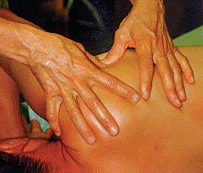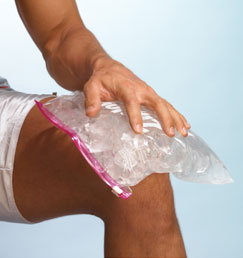Frozen Shoulder
By far, the coolest joint in the body (to me) is the shoulder. It moves in absolutely every direction. The hips are a close second, but there is limited mobility in certain planes of movement.
Mobility in the shoulder provides us all with a multitude of ways to perform very simple everyday activities. The ligaments that hold the upper arm bone, the humerus, a.k.a. the ‘funny bone’, in the socket are quite loose to allow for this wide range of motion. Because they are lax, they don’t do much to hold the shoulder together. Another fact is that the socket in which the top or the “head” of the humerus sits, is a very shallow, concave surface.
What really holds the shoulder together and stabilizes the joint are muscles that are referred to as the rotator cuff (no, it’s not your ‘rotary cup’). There are four small muscles that run from the shoulder blade to the humerus. These muscles completely surround the humerus like a sleeve or cuff. They are very dynamic, contracting to stabilize the shoulder when needed or relaxing to allow you to move the arm freely. The movement of our shoulder is so free and easy that we often take it for granted.
How does a shoulder “freeze“?
Frozen shoulder, also referred to as adhesive capsulitis, typically starts with a minor injury. For example, you may jar your shoulder by tripping and breaking your fall with an outstretched arm. It may also start after an inflammatory problem, like a little tendinitis or bursitis of the shoulder.
When we experience pain in any joint, we will instinctively limit the movements of this area in the hopes of avoiding any further discomfort. Although it is important to limit the movement in the first 24-48 hours of such an injury, further prolonged splinting of the shoulder joint can create a vicious cycle that begins to see a buildup of adhesions (scar tissue). This limited movement in conjunction with the buildup of scar tissue can began to create fibrous tissue around the ligaments, causing them to “lock down”. The greatest area of concern is the lower part of the joint where the ligamentous tissue becomes most lax when immobilized.
Once these adhesions begin to form, the shoulder starts to feel stiff and uncomfortable. You’ll limit your movement in response to the pain and the reduced movement causes more stiffness. Before you know it, you’re trapped in what seems to be a malicious cycle.
If you don’t take care of the problem immediately, it will progress from a little discomfort to severe pain that can interfere with some of the most mindless tasks such as brushing your teeth or combing your hair. After a period of prolonged disuse, your shoulder will become, in a sense, frozen. This lack of movement also begins to cause pain both down the arms and into your neck, causing a cascading impact of what started out as a minor injury.
 If you catch this problem in its early stages, some self-care exercises can assist in regaining full mobility of the joint. Massage is another means in which to tackle this issue early on, but as the adhesions become thick and the pain slowly increases, manual therapy can seem like a form of medieval torture. Personally, I have handled many advanced cases of frozen shoulder with very positive outcomes, but it was not without the great efforts of my patients to be capable of both handling this discomfort (to put it mildly) as well as significant efforts on their part when it came to self-care.
If you catch this problem in its early stages, some self-care exercises can assist in regaining full mobility of the joint. Massage is another means in which to tackle this issue early on, but as the adhesions become thick and the pain slowly increases, manual therapy can seem like a form of medieval torture. Personally, I have handled many advanced cases of frozen shoulder with very positive outcomes, but it was not without the great efforts of my patients to be capable of both handling this discomfort (to put it mildly) as well as significant efforts on their part when it came to self-care.
Conventional treatment for severe cases usually involves manipulation while under an anesthetic. A surgeon will put you under, and while you are asleep, force the joint through a complete range of motion, pulling apart any adhesions. In certain cases, surgery may be required where they need to go in and cut through the adhesions.
Typically, prior to this approach, the doctor may recommend the use of NSAID’s or a cortisone shot. Regardless, one should not expect a speedy resolution to a true condition of frozen shoulder.
There are cases however, that I have been presented with, that all signs and previous diagnosis’s pointed to the shoulder being frozen, but in actuality, there were some stubborn trigger points causing the shoulder to remain immobilized due to the amount of pain the patient was feeling when moving or even while sleeping. These trigger points can be addressed and neutralized to the point where a fully recovery is achieved without the use of any surgery, cortisone or medieval torture rituals and typically in just a few treatments.
If you feel that you may be in the early stages of what seems like frozen shoulder, please discuss your treatment options with your massage therapist before a minor injury becomes a frozen pain.
Ready to #feelbetter?
You're just a click away from a wicked good massage!
-

60 Minute Massage Gift Card
$170.00 Add to cart -

90 Minute Massage Gift Card
$255.00 Add to cart -

Mini Aer Small Room Air Purifier
$149.00 Add to cart -
Sale!

Thera-Pearl Sports Pack/Hot Cold
Original price was: $14.99.$12.99Current price is: $12.99. Add to cart -

3 Somadome Sessions Gift Card
$135.00 Add to cart -

20 Minute Somadome Gift Card
$45.00 Add to cart -
Sale!

TheraBand® Stretch Strap
Original price was: $19.99.$14.99Current price is: $14.99. Add to cart -

TheraBand CLX Connective Loop
$14.99 Select options
May Flowers-Life Hack
April Showers Bring 5 Flower Hacks What do you get when you combine soda, vodka, apple cider vinegar, hair spray & bleach? Some incredible ways to preserve your flowers this season. Sure, April showers bring May flowers, but mother nature went a tad over board with it this April. So how well are you prepared…
Read More#FeelBetterBoston Recap
#FeelBetterBoston Recap The inaugural #FeelBetterBoston Massage & Community Wellness event over Marathon weekend left people with a smile on their face and genuine appreciation for all that was provided. We knew this being the first time we held such an event that we would be competing with the likes of the infamous BAA Expo and other…
Read MoreHow Do You Roll??
How Do You Roll?? Are Foam Rolling Advocates Stretching the Truth? Foam rolling is one of the most common means of self-care for so many people. It has been thought to provide many benefits such as enhanced performance, improved flexibility and speed, pain reduction and muscle recovery. Often it is referred to as a self-massage technique,…
Read MoreOn the Mend
On the Mend As we quickly approach the holy grail of running events, the Boston Marathon, we start to see a rise in our battered and beaten road warriors. Overuse conditions from months of increased training, acute injuries from falls on slippery roads and chronic aches and pains, all result in the patient surrendering to…
Read MoreLife Hack: Watch the SB LIII on TV, but LISTEN on the Radio
Life Hack: Watch the SB LIII on TV, but LISTEN on the Radio So, our beloved Pats are back in the big game again. I’m not going to relay stats and numbers that drive home the dynasty known as the New England Patriots. We are all aware of them. However, if you want to enjoy…
Read MoreCortisone Injections: Yay or Ney?
Cortisone Injections: Yay or Ney? As massage therapists, we often see patients who have been struggling to find an answer for a particular pain problem. Some of these cases are acute (sudden onset) where others may be chronic (reoccurring over a long period of time). It is not uncommon to have a patient ask us…
Read MoreChiropractic Care at The Boston Bodyworker
Chiropractic Care at The Boston Bodyworker We are excited to announce the arrival of Dr. Jean Kelly of Momentum Healthcare to our office. Dr. Kelly has been practicing in our building for the past 10 years and has been a friend to The Boston Bodyworker for almost 20 years. We are honored to have her…
Read MoreSpine Health: Don’t Ignore It!
Spine Health: Don’t Ignore It! The new year always provides us with the feeling of having a clean slate. Let’s face it, most of us don’t take very good care of our spines. 2019 can be the year that your resolutions come true. This lack of care can lead to physical discomfort and make us…
Read MoreLife Hack: Drink Tea
Life Hack: Drink Tea With the rainiest and most dreary Fall in recent time behind us and winter now in full swing, the need for us to provide optimal care for ourselves is high. Despite American’s love affair with coffee, tea is really the more versatile of the beverages. Most of us reach for a…
Read MoreLife Hack: Forward Head Posture
Life Hack: Forward Head Posture How many times in the course of a day do you roll your shoulders and neck around to alleviate “the spot” in between your shoulder blades. There are several reasons for the discomfort you are experiencing, but one way to resolve this is to do what is known as a…
Read More



